一般过去时态和一般现在时态混合练习
一般现在时-一般过去时-一般将来时-现在完成时综合练习
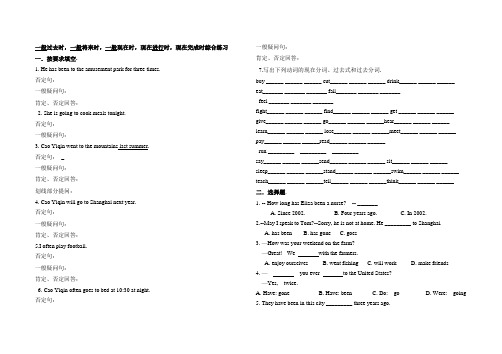
一般过去时,一般将来时,一般现在时,现在进行时,现在完成时综合练习一.按要求填空.1. He has been to the amusement park for three times.否定句:一般疑问句:肯定、否定回答:2. She is going to cook meals tonight.否定句:一般疑问句:3. Cao Yiqin went to the mountains last summer.否定句:_一般疑问句:肯定、否定回答:划线部分提问:4. Cao Yiqin will go to Shanghai next year.否定句:一般疑问句:肯定、否定回答:5.I often play football.否定句:一般疑问句:肯定、否定回答:6. Cao Yiqin often goes to bed at 10:30 at night.否定句:一般疑问句:肯定、否定回答:7.写出下列动词的现在分词、过去式和过去分词.buy ______ ______ ______ cut______ ______ ______ drink______ ______ ______eat_______ _______ _______ fall_______ _______ _______feel _______ _______ _______fight______ ______ ______ find______ ______ ______ get ______ ______ ______ give______ ______ ______ go______ ______ ______hear______ ______ ______learn______ ______ ______ lose______ ______ ______meet______ ______ ______ pay______ ______ ______read______ ______ ______run _________ _________ _________say______ ______ ______send______ ______ ______ sit______ ______ ______sleep______ ______ ______stand______ ______ ______swim______ ______ ______ teach______ ______ ______tell______ ______ ______think______ ______ ______ 二.选择题.1. -- How long has Eliza been a nurse? -- _______A. Since 2002.B. Four years ago.C. In 2002.2.--May I speak to Tom?--Sorry, he is not at home. He _________ to Shanghai.A. has beenB. has goneC. goes3. —How was your weekend on the farm?—Great! We with the farmers.A. enjoy ourselvesB. went fishingC. will workD. make friends4. —you ever to the United States?—Yes, twice.A. Have: goneB. Have: beenC. Do: goD. Were: going5. They have been in this city _________ three years ago.A. forB. aboutC. since6. ―have you been learning English?―I have been learning English for six years.A. How longB. How oftenC. How far7.--Where is Zhang Ming?-- Oh, he _____ to Beijng and he will be back tomorrow.A. has beenB. has goneC. goes8. The Greens____supper now. A:is having B:are;having C:is haveing9.____you usually _____to school with classmates?A. Do, comesB. does, comeC. Do, come10.Mr Green usually______newspapers after supper every day.A. readB. readingC. reads11.______Helen____________(wash )clothes? Yes ,she is .A. Is, washingB. Does , washC. Is, washes12. There ________ a dolphin show in the zoo tomorrow evening.A. wasB. is going to haveC. will haveD. is going to be13. He ________ her a beautiful hat on her next birthday.A. givesB. gaveC. will givingD. is going to giving14. There __________ a meeting tomorrow afternoon.A. will be going toB. will going to beC. is going to beD. will go to be 三.填空题.1.我母亲通常在星期日打扫卫生、洗衣服。
(牛津版初中时态语态练习)一般现在时一般过去时一般将来时现在进行时混合练习2(附答案)

一、根据要求改写下列句子。
一、根据要求改写下列句子。
1.This is my pencil. (变为一般疑问句) Is this your pencil? 2.She is going on a trip to Beijing now. (用I做主语改写句子) I am going on a trip to Beijing now. 3.He found some meat in the fridge. (改为一般疑问句) Did he find any meat in the fridge? 4.It is going to be a fine day tomorrow. (改为否定句) It isn’tgoing to be a fine day tomorrow. 5.I stay at home on Saturdays. (对划线部分提问) What do you do on Saturdays? 6.That bird is red. (对划线部分提问) What color is that bird? 7.They are having lunch at school at the moment. (对划线部分提问) What are they doing at school at the moment? 8.Lucy doesn't have sports every day. (变为肯定句) Lucy has sports every day. 9.She stayed there for a week. (对划线部分提问) How long did she stay there? 10.He came back just now. (用in two days改写句子) He will come back in two days. 11.He likes the black bag very much. (变为否定句) He doesn't like the black bag at all. 12.I spend only 45 yuan on the coat. (用she改写句子) She spends only 45 yuan on the coat. 13.There were some oranges in the cup. (改为一般疑问句) Were there any oranges in the cup? 14.I am going to come to the get-together tomorrow. (改为一般疑问句) Are you going to come to the get-together tomorrow? 15.The girl is si ng on the blue box. (改为一般疑问句) Is the girl si ng on the blue box? 16.She lives in a small town near Beijing. (改为一般疑问句) Does she live in a small town near Beijing? 17.--- Will the twins buy the red T-shirt? (做肯定回答) --- Yes, they will. 18.is, what, the girl, over there, in red, doing (?) (连词成句) What is the girl in red doing over there? 19.Amy took some photos at the zoo last Saturday. (改为否定句) Amy didn't take any photos at the zoo last Saturday. 20.We have a music class on Thursday. (用right now改写句子) We are having a music class right now. 21.Mr. Brown will visit the Great Wall next summer. (对划线部分提问) What will Mr. Brown do next summer? 22.Do you o en take exercise? (用now改写句子) Are you taking exercise now? 23.Lucy did her homework at home. (改为否定句) Lucy didn't do her homework at home. 25.I’m going to listen to music next Sunday. (对话向部分提问) What are you going to do next Sunday? 26.I arrived just a few minutes ago. (对划线部分提问) When did you arrive? 27.He is doing his homework. (改为复数句) They are doing their homework. 28.Daniel will meet you at the airport this evening. (改为一般疑问句) Will Daniel meet you at the airport this evening? 29.We’ll be back in about an hour. (对划线部分提问) How soon will you be back? 30.Robert was a taxi-driver. (改为同义句) Robert used to be a taxi-driver. 31.Everyone in enjoying themselves. (改为同义句) Everyone is having a good me. 32.There are two libraries in that town. (用next year改写句子) There will be two libraries in that town next year. 33.Tony is going to play football with us. (对划线部分提问) Who is going to play footballwith us? 34.It'san English-Chinese dic onary. (对划线部分提问) What is it? 二、单项选择。
初一英语时态的混合使用单选题30题
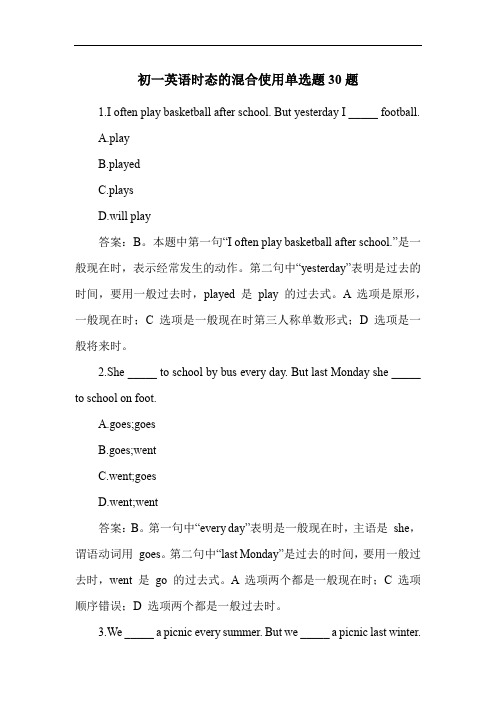
初一英语时态的混合使用单选题30题1.I often play basketball after school. But yesterday I _____ football.A.playB.playedC.playsD.will play答案:B。
本题中第一句“I often play basketball after school.”是一般现在时,表示经常发生的动作。
第二句中“yesterday”表明是过去的时间,要用一般过去时,played 是play 的过去式。
A 选项是原形,一般现在时;C 选项是一般现在时第三人称单数形式;D 选项是一般将来时。
2.She _____ to school by bus every day. But last Monday she _____ to school on foot.A.goes;goesB.goes;wentC.went;goesD.went;went答案:B。
第一句中“every day”表明是一般现在时,主语是she,谓语动词用goes。
第二句中“last Monday”是过去的时间,要用一般过去时,went 是go 的过去式。
A 选项两个都是一般现在时;C 选项顺序错误;D 选项两个都是一般过去时。
3.We _____ a picnic every summer. But we _____ a picnic last winter.A.have;hadB.had;haveC.have;haveD.had;had答案:A。
第一句中“every summer”表示一般现在时,用have。
第二句中“last winter”表明是过去的时间,用had。
B 选项顺序错误;C 选项两个都是一般现在时;D 选项两个都是一般过去时。
4.He _____ his homework after dinner. But he _____ his homework after breakfast yesterday.A.does;didB.did;doesC.does;doesD.did;did答案:A。
一般现在时、一般过去时、现在进行时混合练习

⼀般现在时、⼀般过去时、现在进⾏时混合练习⼀般现在时、⼀般过去时、现在进⾏时混合练习⼀.⽤词的适当形式填空。
1.The children ___________ (run) there now.2.I ________ up at half past six this morning. (get )3.It's time ___________ (have ) sports.4.My mother ____________ a lot of fruit yesterday afternoon . (buy)5.Please _______ (put) the ball in the box.6.They ________ _________ a meeting yesterday. ( not have)7.- ___________ you _________ ( have) any colour pens?-Sorry, I don't have any.8.She likes eggs, but she__________________ (not like) bread.9.Lucy helped the old man____________ the big basket. (carry)10.- Does he like it? - Yes, he________.11.- How much meat ________ you ___________ (want) ? - A kilo, please.12.Can you come and ___________ (play) football with us?13.There __________ (be) a pen and two erasers in the pencil- box. 14.You must _________ (get) here at two this afternoon.15.The twins _________ thirteen two years ago. (be)16. Where __________ her friend_____________ (swim) now, do you know?17.We must __________ (help ) the teacher carry it.18.Who __________ (teach) you English in your school?19.Would you like _____________ (eat) an apple?20.Look! The bus____________________ (come). 21.Near our school there _________ (be) a shop, it _________ (sell) a lot of books.22.I don't want __________ (buy) any food. But he _________ (want).23.What _______ he _________ (like) ?24.He __________ (teach) English ina middle school.25.Han Ling likes __________ (make) things.26.- What ________ she___________ (do)?-She _________ ______________ (clean) her room now.27.Look at the man. He__________________ (drink) tea. 28.He can ___________ (sing) thissong.29.Let's ___________ ( help ) my mother ___________ (cook).30.I think Li Lei must______________ (be) at school. 31.There __________ (be) some bread and meat on the table.32.Listen! She __________ (sing) an English song.33.Liu Ying ___________ (study) in Beijing now.34.They _____________________ (clean) the floor now.35.Look! He ___________________ (drink) water.36.Han Meimei often ____________ (play) games after school.37.Lily _______________ (be) a Young Pioneer.38.Please ___________ (close) the window, Wu Dong.39.What __________ the girls__________ (do) over there now? 40.Let's ______________ (help ) her.41.Where _______ your pen pal______ (come ) from?42.The boy is ___________ (watch) TV at home.43.Can they finish ____________ (read) the story?44.Look, the girls__________________ (wear) new clothes.45.___________ ( be ) you sitting and drinking tea?46.One of the people_____________ (be) singing.47.What are they doing? They_________________ (clean) the room.48._________ (be) there any cups of tea? No, there ___________ (be) not any.49.Look! Lucy ______________ (fly)a kite with Lily.50.I can ___________ (speak) Chinese and English.51.How ______ you ___________ (do) ?52.She ____________ (look) like her mother.53.I ___________ (not) think so.54.My friends _____________ (play) cards now.55.Listen! Who _____________ (sing) in the classroom?56.Jim ___________ (have) a good friend.57.Where ___________ (do) your friend come from?59.I like enjoy _________ (listen) to music after work every day.60.She ___________ (live) in the city.61.We have two pen __________(pal) from England.62.Class One _________ (have) a map of China.63.Let's ____________ (introduce)to each other.64.You must finish __________ (write ) the question now.65.Miss Wang teaches __________ (we) Chinese.66.She is busy _____________ (play) volleyball.67.It's time _____________ (get ) up.68.There are __________________ (thirteenth) girls in our class.69.Jim is busy ___________ (make )a card.70.Mr Green ___________ (teacher) them English every day.71.The little girl __________ (have)a round face.72.He can't ________ (go) there with us.73.I can't _____________ (play) the piano.74.We can help him with________________ (dance).75.She wants ____________ (join) the music club.77.They are busy ______________ (learn) English now.78.The music __________ (sound) very great. 79.____________ (read) books is good for us.80.We can ____________ (learn) a lot about English.81.She _______________ (not like) opera.82.He even wants _____________ (be) a famous artist.83.Someone __________ (be) in the next room.84.Tom often _____________ (sing ) Japanese songs.85.Jack often __________ ( swim) in the river.86.What time_________ his father usually________(do) the work? 87. I _________ (have) an exciting party last weekend.88.He usually _________(get) up at five o’clock.89. It’s nine o’clock. Myfather_______________(work) in the office.90. _________ she_________(practice) her guitar yesterday? No, she _________. 91.__________ you_________(brush) your teeth every morning.92.What ________ ( do ) he usually ________( do ) after school?93. What ________ Tom ________ (do) on Saturday evening?He ________(watch) TV and__________(read) an interesting book.94.__________he__________(clean) the classroom? No, he isn’t.He____________(play).95.Tom ________ ( study ) English, Chinese, Maths, Science and Art at school.96. Where is Mak?He___________(run) on the grass. 97.How many lessons________ your classmates______( have ) on Monday?98.Look, Sally andMary______(swim) in the river.99. They all _________(go) to the mountains yesterday morning.100.She _________(not visit) her aunt last weekend.She ________ (stay) at home and_________(do) some cleaning.101.We often___________ ( play ) football in the playground.102.. How _________(be) Jim's weekend? It _________(be not) bad.103. ________ (be) your mother a sales assistant(销售助理) last year? No. she __________.104.We ___________ ( play ) football in the playground now.105.My mother __________(cook) some nice food now.106. ________ Mr. Li__________(do) the project on Monday morning? Yes, he_________.107. Where is Mak?He___________(run) on the grass.108. My friend, Carol,________(study) for the math test and ________(practice) English last night.⼆、单选1“______Tom visit his uncle yesterd ay afternoon?”“No,he______.”A、Did; didB、Did; didn'tC、Does; doesn'tD、Do; don't 2:She______at home last vacation.A、didn't stayB、didn't stayedC、don't stayD、doesn't stay 3:Last week Li Xin and I______to a m ovie.A、goB、goesC、goingD、went4:—Where's your sister?—I think she______a talk now.A、givesB、giveC、gaveD、is giving5:—Listen, what's the noise?—My brother______the programme of the World Cup in the sitting-room.A、watchesB、is watchingC、has watchedD、will watch6.Yesterday the girls ______to the p ark and______a good time.A、go; haveB、went; haveC、went; hadD、goes; has 7:Don't turn on the TV. Grandma_____ now.A、is sleepingB、will sleeping C、sleptD、sleeps错误!未找到引⽤源。
一般现在时和一般过去时混合练习
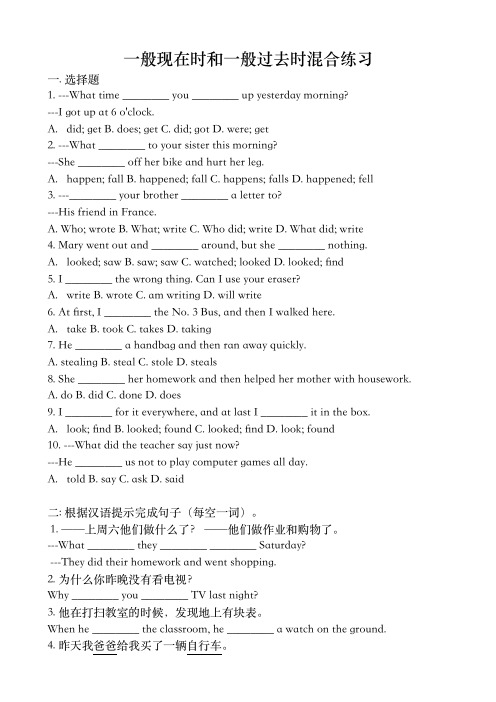
⼀般现在时和⼀般过去时混合练习⼀. 选择题1. ---What time ________ you ________ up yesterday morning?---I got up at 6 o'clock.A.did; getB. does; getC. did; gotD. were; get2. ---What ________ to your sister this morning?---She ________ off her bike and hurt her leg.A.happen; fallB. happened; fallC. happens; fallsD. happened; fell3. ---________ your brother ________ a letter to?---His friend in France.A. Who; wroteB. What; writeC. Who did; writeD. What did; write4. Mary went out and ________ around, but she ________ nothing.A.looked; sawB. saw; sawC. watched; lookedD. looked; find5. I ________ the wrong thing. Can I use your eraser?A.writeB. wroteC. am writingD. will write6. At first, I ________ the No. 3 Bus, and then I walked here.A.takeB. tookC. takesD. taking7. He ________ a handbag and then ran away quickly.A. stealingB. stealC. stoleD. steals8. She ________ her homework and then helped her mother with housework.A. doB. didC. doneD. does9. I ________ for it everywhere, and at last I ________ it in the box.A.look; findB. looked; foundC. looked; findD. look; found10. ---What did the teacher say just now?---He ________ us not to play computer games all day.A.toldB. sayC. askD. said⼆: 根据汉语提⽰完成句⼦(每空⼀词)。
一般现在时一般过去时一般将来时现在进行时混合练习2附答案
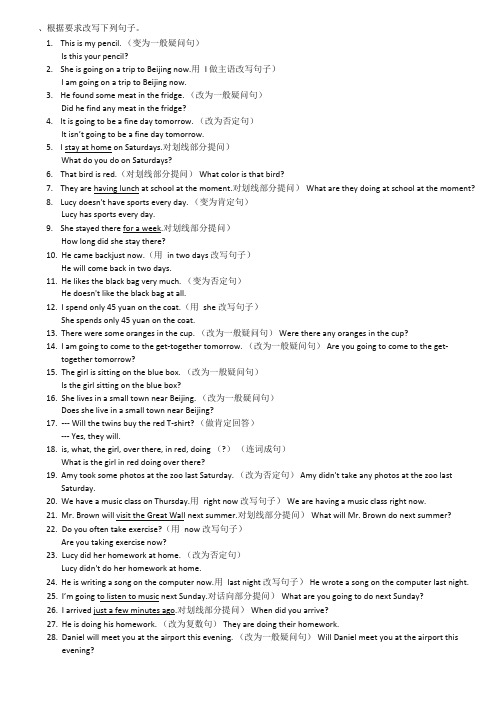
、根据要求改写下列句子。
1.This is my pencil. (变为一般疑问句)Is this your pencil?2.She is going on a trip to Beijing now.用I 做主语改写句子)I am going on a trip to Beijing now.3.He found some meat in the fridge. (改为一般疑问句)Did he find any meat in the fridge?4.It is going to be a fine day tomorrow. (改为否定句)It isn’t going to be a fine day tomorrow.5.I stay at home on Saturdays.对划线部分提问)What do you do on Saturdays?6.That bird is red.(对划线部分提问) What color is that bird?7.They are having lunch at school at the moment.对划线部分提问) What are they doing at school at the moment?8.Lucy doesn't have sports every day. (变为肯定句)Lucy has sports every day.9.She stayed there for a week.对划线部分提问)How long did she stay there?10.He came backjust now.(用in two days 改写句子)He will come back in two days.11.He likes the black bag very much. (变为否定句)He doesn't like the black bag at all.12.I spend only 45 yuan on the coat.(用she 改写句子)She spends only 45 yuan on the coat.13.There were some oranges in the cup. (改为一般疑问句) Were there any oranges in the cup?14.I am going to come to the get-together tomorrow. (改为一般疑问句) Are you going to come to the get-together tomorrow?15.The girl is sitting on the blue box. (改为一般疑问句)Is the girl sitting on the blue box?16.She lives in a small town near Beijing. (改为一般疑问句)Does she live in a small town near Beijing?17.--- Will the twins buy the red T-shirt? (做肯定回答)--- Yes, they will.18.is, what, the girl, over there, in red, doing (?)(连词成句)What is the girl in red doing over there?19.Amy took some photos at the zoo last Saturday. (改为否定句) Amy didn't take any photos at the zoo lastSaturday.20.We have a music class on Thursday.用right now 改写句子) We are having a music class right now.21.Mr. Brown will visit the Great Wall next summer.对划线部分提问) What will Mr. Brown do next summer?22.Do you often take exercise?(用now 改写句子)Are you taking exercise now?23.Lucy did her homework at home. (改为否定句)Lucy didn't do her homework at home.24.He is writing a song on the computer now.用last night 改写句子) He wrote a song on the computer last night.25.I’m going t o listen to music next Sunday.对话向部分提问) What are you going to do next Sunday?26.I arrived just a few minutes ago.对划线部分提问) When did you arrive?27.He is doing his homework. (改为复数句) They are doing their homework.28.Daniel will meet you at the airport this evening. (改为一般疑问句) Will Daniel meet you at the airport thisevening?29.We’ll be bac k in about an hour.对划线部分提问) How soon will you be back?30.Robert was a taxi-driver. (改为同义句) Robert used to be a taxi-driver.31.Everyone in enjoying themselves. (改为同义句) Everyone is having a good time.32.There are two libraries in that town. (用next year 改写句子) There will be two libraries in that town next year.33.Tony is going to play football with us.对划线部分提问) Who is going to play football with us?34.It's an English-Chinese dictionary.(对划线部分提问) What is it?二、单项选择。
高一英语动词时态混合练习(含一般过去时、现在完成时、过去完成时等)单选题30题
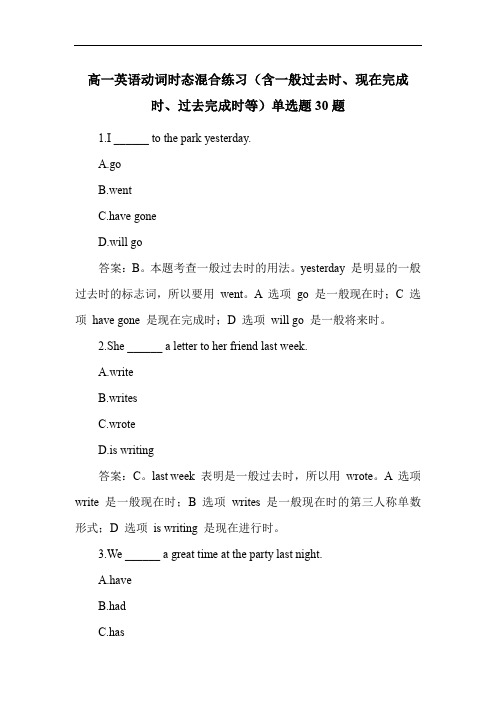
高一英语动词时态混合练习(含一般过去时、现在完成时、过去完成时等)单选题30题1.I ______ to the park yesterday.A.goB.wentC.have goneD.will go答案:B。
本题考查一般过去时的用法。
yesterday 是明显的一般过去时的标志词,所以要用went。
A 选项go 是一般现在时;C 选项have gone 是现在完成时;D 选项will go 是一般将来时。
2.She ______ a letter to her friend last week.A.writeB.writesC.wroteD.is writing答案:C。
last week 表明是一般过去时,所以用wrote。
A 选项write 是一般现在时;B 选项writes 是一般现在时的第三人称单数形式;D 选项is writing 是现在进行时。
3.We ______ a great time at the party last night.A.haveB.hadC.hasD.will have答案:B。
last night 提示用一般过去时,had 正确。
A 选项have 是一般现在时;C 选项has 是一般现在时的第三人称单数形式;D 选项will have 是一般将来时。
4.He ______ born in 1998.A.isB.wasC.will beD.has been答案:B。
in 1998 是过去的时间,用一般过去时was。
A 选项is 是一般现在时;C 选项will be 是一般将来时;D 选项has been 是现在完成时。
5.They ______ to the zoo two days ago.A.goB.wentC.have goneD.goes答案:B。
two days ago 是一般过去时的标志词,went 正确。
A 选项go 是一般现在时;C 选项have gone 是现在完成时;D 选项goes 是一般现在时的第三人称单数形式。
一般现在时和过去时练习题

一般现在时和过去时练习题一般现在时和过去时是英语语法中两个最基本的时态。
一般现在时用来表示经常性的或习惯性的动作、状态、真理等,而过去时则用来表示过去发生的动作或状态。
下面是一些关于一般现在时和过去时的练习题及参考答案。
练习题一:根据提示填入动词的正确形式。
1. She __________ (live) in Paris now.2. They __________ (not play) basketball every day.3. I usually __________ (go) to the gym on weekends.4. We __________ (not eat) dinner yet.5. The train __________ (arrive) at 9 am every morning.参考答案:1. lives2. do not play3. go4. have not eaten5. arrives练习题二:选择正确的动词形式填空。
1. I __________ (watch/watched) a movie last night.2. He always __________ (drink/drinks) coffee in the morning.3. We __________ (study/studies) English every day.4. They __________ (go/goes) to the beach every summer.5. She __________ (is/are) a teacher.1. watched2. drinks3. study4. go5. is练习题三:改写下列句子,从一般现在时改为过去时。
1. She drinks coffee every morning.2. They go to the park on Sundays.3. I play tennis twice a week.4. We usually eat dinner at home.5. The train arrives at 9 am every morning.参考答案:1. She drank coffee every morning.2. They went to the park on Sundays.3. I played tennis twice a week.4. We usually ate dinner at home.5. The train arrived at 9 am every morning.练习题四:改写下列句子,从过去时改为一般现在时。
- 1、下载文档前请自行甄别文档内容的完整性,平台不提供额外的编辑、内容补充、找答案等附加服务。
- 2、"仅部分预览"的文档,不可在线预览部分如存在完整性等问题,可反馈申请退款(可完整预览的文档不适用该条件!)。
- 3、如文档侵犯您的权益,请联系客服反馈,我们会尽快为您处理(人工客服工作时间:9:00-18:30)。
三、句型转换
1.They came to China in 1990.(变一般疑问句) __________ they ________ to China in 1990?
3. The twins go to school on foot every day. (同上) _________ the twins _______ to school on foot every day?
4.She washed the clothes last Sunday. ( 变否定句) She _________ ________ the clothes last Sunday.
5. She did some shopping yesterday. (变否定句) _______________________________________
6. My mother likes her students. (变一般疑问句) _______________________________________
7. Do you watch TV on Sunday? (用last Sunday 改写成过去时态的句子)
______________________________________________?
8. Wei Hua bought a new pen yesterday. (变否定句) Wei Hua________ ________ a new pen yesterday.
9. We had a meeting the day before yesterday. (变一般疑问句)
_______ you _______ a meeting the day before yesterday?
10. They had a good time last Sunday. (同义句) They ___________ __________ last Sunday.
11. There were some cars in front of the house just now.
否定句:There _______ ________ cars in front of the house just now.
一般疑问句:______ there _____ cars in front of the house just now?
12. He went to the zoo with his father yesterday.
否定句:He ________ _______ to the zoo with his father yesterday.
一般疑问句:______ he ______ to the zoo with his father yesterday?
特殊疑问句:__________ __________ he __________ yesterday?
将下列句子改成一般过去时
1. Tom speaks Chinese every day.
2. We have four lessons.
3. I watch TV every day.
4. She works in a hospital.
5. Do you like this book?
6. Kitty and Ben have lunch at about twelve.
9. They watch TV in the evening.。
